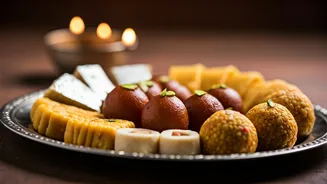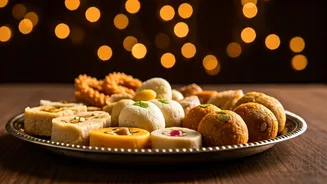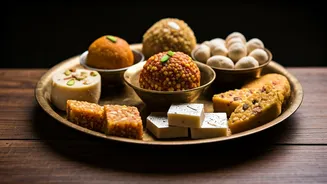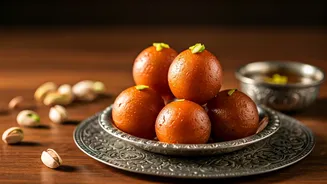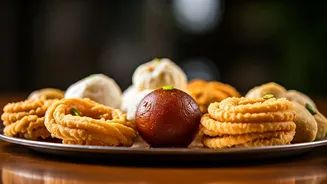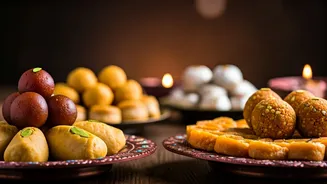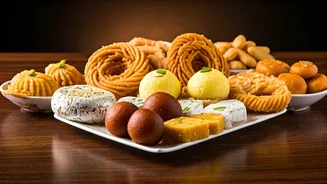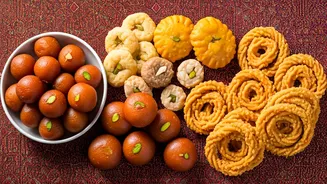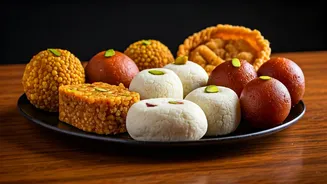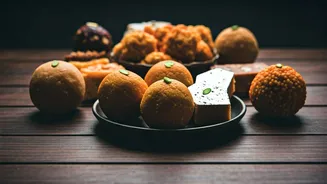Sweet Introductions
Diwali, the vibrant Festival of Lights, is a time of joy, togetherness, and, of course, an array of delectable sweets. The tradition of sharing sweets during
Diwali symbolizes the sweetness of life and the triumph of good over evil. Across India, the preparation of these festive treats is a cherished family activity, often passed down through generations. These sweets represent not just taste, but also the culture and spirit of the occasion. Popular sweets such as Gulab Jamuns, with their soft, melt-in-your-mouth texture, are a beloved classic. Thenkuzhal, another popular treat, provides a delightful contrast of textures. The variety of options ensures there's something to please every palate. The preparation often involves a mix of tradition and creativity, where families can add their unique twist on a classic recipe. These traditional sweets, carefully prepared and shared, are at the very heart of the Diwali spirit.
Gulab Jamun's Charm
Gulab Jamuns, perhaps the most iconic of Indian sweets, are small, round dumplings traditionally made from milk solids (khoya or mawa) that are deep-fried and then soaked in a sugar syrup infused with rose water, cardamom, and sometimes saffron. The name 'Gulab Jamun' itself is a testament to its beauty, with 'gulab' meaning rose and 'jamun' referring to the fruit with a similar shape. The key to the perfect Gulab Jamun lies in achieving the right texture – a soft, spongy interior and a slightly crispy exterior. This involves careful kneading of the dough and the right frying temperature to ensure the dumplings cook evenly. The sugar syrup, not too thick or thin, should completely saturate the dumplings, adding its sweetness and aroma. Gulab Jamuns are often served warm, either on their own or with a scoop of vanilla ice cream. The aroma of rose and cardamom adds an extra layer of delight.
Mouthwatering Mysorepak
Mysorepak is a melt-in-your-mouth sweet that exemplifies the richness of South Indian cuisine. Originating from the royal kitchens of Mysore, this treat is made with gram flour (besan), ghee, and sugar. The process involves slow cooking, where the gram flour is roasted until golden, then mixed with sugar syrup and copious amounts of ghee. The ghee adds a unique richness, contributing to the signature melt-in-your-mouth quality of Mysorepak. As the mixture thickens, it's poured onto a tray and allowed to set, often taking on a porous, honeycomb-like texture. There are variations, depending on the desired consistency; some are softer, while others are more crumbly. Mysorepak is a celebration of ghee and skill. The perfect Mysorepak strikes a delicate balance between sweetness and the nutty flavor of roasted gram flour, making it a beloved dessert across India, particularly during festivals.
Thenkuzhal and Murukku
Thenkuzhal and other varieties of murukku are crispy, savory snacks that often complement the sweets during Diwali celebrations. Thenkuzhal, also known as 'coconut coil,' is made using rice flour, urad dal flour, and coconut milk, which imparts a unique flavor. The dough is shaped into spiral coils using a murukku press and deep-fried until golden and crispy. These snacks have a satisfying crunch and a subtle coconut taste, which offers a delightful contrast to the sweetness of the other Diwali treats. The preparation requires skill in handling the dough and ensuring the murukku retains its shape during frying. Magizhampoo murukku, another variety, is similarly made but with different seasonings, offering a variety of flavors for those who want a wider range of options. Murukku, in its different forms, represents the diversity of Indian snacks, with each region or family having its unique recipe and variations. They're typically served as a savory counterpoint to the sweetness of the other festive foods.
Exploring Ras Malai
Ras Malai is a luxurious dessert that perfectly embodies the creamy richness that Indian sweets are known for. It consists of soft, spongy cheese patties (chenna) soaked in sweetened, thickened milk (rabri) that is infused with cardamom and saffron, and sometimes garnished with nuts. The chenna patties are cooked in sugar syrup until they are light and airy, then carefully immersed in the sweetened milk to absorb its flavor. The milk is traditionally reduced slowly, which gives it a thick, velvety texture, enhanced by cardamom and saffron. The combination of the soft chenna and the creamy milk creates a sensory delight. There are variations in the density of the milk and the size of the chenna patties, but the core essence of a creamy, flavorful experience remains constant. Ras Malai embodies the artistry and the attention to detail that goes into creating Indian sweets.
More Sweet Delights
Apart from Gulab Jamuns, Mysorepak, Thenkuzhal, and Ras Malai, there are many other sweets that find their way onto Diwali platters. Jilebi, with its spiraled shape and bright orange color, is a popular choice; it’s a deep-fried sweet made from fermented batter, soaked in sugar syrup. Badusha, a flaky, deep-fried pastry, offers a unique texture and flavor. Kalakand, made with paneer and condensed milk, is another creamy and delicate sweet. Seven cup cake is another popular choice. Cham Cham and Ghee Mysorepak are some of the other sweets that add to the variety of textures and flavors. These, along with other sweets, contribute to a spread that reflects the diversity and richness of Indian culinary traditions, creating a symphony of flavors that define the Diwali festival. The variety ensures that every member of the family finds a dessert to love.
